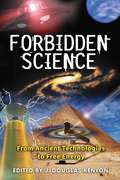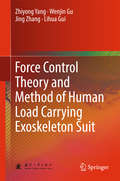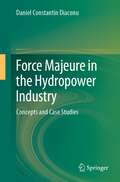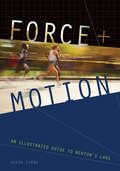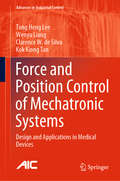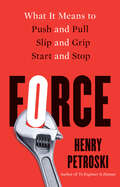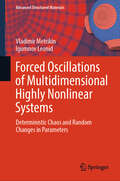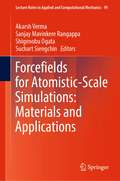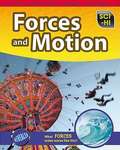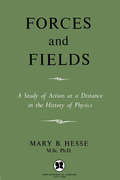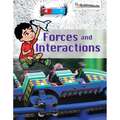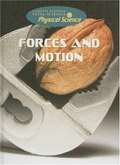- Table View
- List View
Forbidden Science: From Ancient Technologies to Free Energy
by J. Douglas KenyonReveals the cutting edge of New Science and shows how established science disallows inquiry that challenges the status quo--even when it produces verifiable results • Contains 43 essays by 19 researchers denoting cutting-edge, heretical, or suppressed scientific research, including Immanuel Velikovsky, Nikola Tesla, Rupert Sheldrake, and Masaru Emoto • Edited by Atlantis Rising publisher, J. Douglas KenyonFollowing the model of his bestselling Forbidden History and Forbidden Religion, J. Douglas Kenyon has assembled from his bimonthly journal, Atlantis Rising, material that explores science and technology that has been suppressed by the orthodox scientific community--from the true function of the Great Pyramid and the megaliths at Nabta Playa to Immanuel Velikovsky’s astronomical insights, free energy from space, cold fusion, and Rupert Sheldrake’s research into telepathy and ESP.There is an organized war going on in science between materialistic theory and anything that could be termed spiritual or metaphysical. For example, Masaru Emoto’s research into the energetics of water, although supported by photographic evidence, has been scoffed at by mainstream science because he has asserted that humans affect their surroundings with their thoughts. The materialism or absolute skepticism of the scientific establishment is detrimental to any scientific inquiry that thinks outside the box. This mentality is interested in preserving funding for its own projects, those that will not rock the establishment. From Tesla’s discovery of alternating current to Robert Schoch’s re-dating of the Sphinx, this book serves as a compelling introduction to the true history of alternative and New Science research.
Force (Force & Motion)
by George GraybillThis books provides ready-to-use information and activities for remedial students in grades five to eight. Written to grade using simplified language and vocabulary, science concepts are presented in a way that makes them more accessible to students and easier for them to understand. Comprised of reading passages, student activities and overhead transparencies, our resource can be used effectively for whole-class, small group and independent work.
Force Control Theory and Method of Human Load Carrying Exoskeleton Suit
by Jing Zhang Zhiyong Yang Wenjin Gu Lihua GuiThis book reports on the latest advances in concepts and further development of principal component analysis (PCA), discussing in detail a number of open problems related to dimensional reduction techniques and their extensions. It brings together research findings, previously scattered throughout many scientific journal papers worldwide, and presents them in a methodologically unified form. Offering vital insights into the subject matter in self-contained chapters that balance the theory and concrete applications, and focusing on open problems, it is essential reading for all researchers and practitioners with an interest in PCA
Force Majeure in the Hydropower Industry: Concepts and Case Studies
by Daniel Constantin DiaconuThis book aims to highlight the particular situation faced by certain hydropower companies by the fact that they cannot fulfil their contracts due to force majeure. The first part of this book will be an analysis of how water is used in electricity production. It is important to point out that all types of energy sources use water, to a different extent, of course, and that its spatial and temporal availability is very important. The focus will be on hydropower, presenting the current situation at the global level, and the effect of reducing the amounts of water in the river system.The second part is based on the presentation of the concept of force majeure and the ways of presenting and drafting it in a contract. Many disputes or the success of a contract depended heavily on the provisions of this article of the contract. Obviously, there are also situations in which the signatory parties abuse or are not protected by these provisions of force majeure. Starting from a few brief examples from the international level, we reach a wide discussion of the situation created in Romania, when the largest supplier of electricity produced on the basis of water terminates several contracts invoking force majeure. The manner in which the opinion of the parties involved is presented to the court is analyzed and presented in detail.
Force and Motion Engineering Internship, Engineering Notebook with Article Compilation
by Lawrence Hall of ScienceHow can you get critical supplies to people in need after a natural disaster? If you drop a pod of supplies, what pod materials and features will make safe and successful delivery of food and medical supplies? That’s what you will figure out as you and your classmates take on the role of mechanical engineering interns with Futura Engineering, a company that specializes in designing solutions for the world’s problems. As an intern, you will work to apply your knowledge of forces and motion to help design a pod that will deliver emergency aid packages to people in remote areas where disasters such as earthquakes, landslides, or floods have made it dangerous or impossible to deliver aid by trucks. You will design and test your pod using a digital tool called SupplyDrop, and consider different design aspects: the pod’s shell material, the type and amount of internal padding, and whether you will add additional external features like a parachute or landing legs to your pod. Your supply pod design must protect the cargo by minimizing damage to supplies, offer possibilities for reusing the pod’s shell for shelter, and be as low-cost as possible.
Force and Motion Resources: Images,Data and Readings
by FOSS Middle School Staff AssociatesScience Textbook
Force and Motion: An Illustrated Guide to Newton's Laws
by Jason ZimbaIsaac Newton developed three laws of motion that govern the everyday world. These laws are usually presented in purely mathematical forms, but Jason Zimba breaks with tradition and treats them visually. This unique approach allows students to appreciate the conceptual underpinnings of each law before moving on to qualitative descriptions of motion and, finally, to the equations and their solutions.Zimba has organized the book into seventeen brief and well-sequenced lessons, which focus on simple, manageable topics and delve into areas that often cause students to stumble. Each lesson is followed by a set of original problems that have been student-tested and refined over twenty years. Zimba illustrates the laws with more than 350 diagrams, an innovative presentation that offers a fresh way to teach the fundamentals in introductory physics, mechanics, and kinematics courses.
Force and Position Control of Mechatronic Systems: Design and Applications in Medical Devices (Advances in Industrial Control)
by Tong Heng Lee Kok Kiong Tan Clarence W. de Silva Wenyu LiangForce and Position Control of Mechatronic Systems provides an overview of the general concepts and technologies in the area of force and position control. Novel ideas and innovations related to this area are presented and reported in detail, and examples of applications in medical technology are given.The book begins by introducing force sensing, and modelling of contacting objects. In then moves steadily through a variety of topics, including:• disturbance observer-based force estimation;• force-based supervisory control;• stabilization systems;• controller design; and• control of tube insertion procedures.This book will be of interest to researchers, engineers and students interested in force control, particularly those with a focus on medical applications of these ideas.Advances in Industrial Control reports and encourages the transfer of technology in control engineering. The rapid development of control technology has an impact on all areas of the control discipline. The series offers an opportunity for researchers to present an extended exposition of new work in all aspects of industrial control.
Force, Motion, and Energy
by Uri Haber-Schaim H. Graden Kirksey Reed Cutting Harold A. Pratt Robert D. StairForces <p><p> Pressure <p> Forces Acting in Different Directions <p> Distance, Time, and Speed <p> Waves <p> Heating and Cooling <p> Potential Energy and Kinetic Energy
Force, Motion, and Work: Module K
by Leonard Bernstein Martin Schachter Alan Winkler Stanley WofeScience textbook
Force: What It Means to Push and Pull, Slip and Grip, Start and Stop
by Henry PetroskiAn eminent engineer and historian tackles one of the most elemental aspects of life: how we experience and utilize physical force &“Another gem from a master of technology writing.&”—Kirkus Reviews Force explores how humans interact with the material world in the course of their everyday activities. This book for the general reader also considers the significance of force in shaping societies and cultures. Celebrated author Henry Petroski delves into the ongoing physical interaction between people and things that enables them to stay put or causes them to move. He explores the range of daily human experience whereby we feel the sensations of push and pull, resistance and assistance. The book is also about metaphorical force, which manifests itself as pressure and relief, achievement and defeat. Petroski draws from a variety of disciplines to make the case that force—represented especially by our sense of touch—is a unifying principle that pervades our lives. In the wake of a prolonged global pandemic that increasingly cautioned us about contact with the physical world, Petroski offers a new perspective on the importance of the sensation and power of touch.
Forced Oscillations of Multidimensional Highly Nonlinear Systems: Deterministic Chaos and Random Changes in Parameters (Advanced Structured Materials #222)
by Vladimir Metrikin Igumnov LeonidThis book highlights the presentation of methods for studying oscillations under external periodic influence and random changes in parameters in dynamic systems with nonlinearities that have discontinuities and kinks. The analysis of dynamic systems is based on effective approaches and algorithms of the method of point mappings of Poincaré surfaces, developed by the Nizhny Novgorod Scientific School of academician A.A. Andronov. Considerable attention is paid to the study of the general picture of the possible behavior of systems and their use in solving various applied problems. Using specific examples, it is found that this research approach allows not only to advance in the study of known nonlinear features but also to discover new effects and applications. The presentation is illustrated by numerous specific examples of oscillatory strongly nonlinear systems with discontinuous nonlinearities or piecewise-continuous nonlinearities. A separate chapter is devoted to the development and use of the point mapping method for random changes in the parameters of dynamic systems, as well as in dynamic systems subject to external seismic loads. The book is intended for scientists and engineers who are engaged in research and practice activities related to the theory of nonlinear oscillations and its applications, as well as graduate students and senior undergraduate students in relevant majors.
Forcefields for Atomistic-Scale Simulations: Materials and Applications (Lecture Notes in Applied and Computational Mechanics #99)
by Suchart Siengchin Sanjay Mavinkere Rangappa Akarsh Verma Shigenobu OgataThis book describes the forcefields/interatomic potentials that are used in the atomistic-scale and molecular dynamics simulations. It covers mechanisms, salient features, formulations, important aspects and case studies of various forcefields utilized for characterizing various materials (such as nuclear materials and nanomaterials) and applications. This book gives many help to students and researchers who are studying the forcefield potentials and introduces various applications of atomistic-scale simulations to professors who are researching molecular dynamics.
Forces And Motion
by Casey RandHow does friction help you ride a bicycle? How does a submarine keep from sinking? What is equilibrium? The visually stimulating 'Sci-Hi' books take learning science core curriculum to a whole new exciting level. Each title explores an area of life, physical, or earth science in a way that is both engaging and comprehensive.
Forces Make Things Move
by Kimberly Brubaker BradleyForces are at work all around you. They affect things as small as a toy car and as big as the earth! Forces make things move, but they also make things stop. Some forces are very strong, but other forces are so weak, you can't feel them at all. But what are forces, and how do they work? Read and find out!
Forces and Fields
by Mary B. HesseForces and Fields by Mary Hesse is a history of physics surrounding the question: How do bodies act on one another across space? Hesse illustrates this through various answers, discussing period of transition in fundamental physics in which new concepts and ideas have been introduced and made scientifically testable, and makes a certain philosophical interpretation of science from the beginning. Some topics include the logical status of theories, primitive analogies, mechanism in Greek science, the Greek inheritance, Corpuscular Philosophy, The Theory of Gravitation and The Theory of Relativity, as well as others. Mary B. Hesse (born 1924) is a contemporary English philosopher of science. She is now professor emerita of the philosophy of science at Cambridge University. Her publication Models and Analogies in Science is a widely cited and accessible introduction to the topic. Hesse argues, contra Duhem, that models and analogies are integral to understanding scientific practice in general and scientific advancement in particular, especially how the domain of a scientific theory is extended and how theories generate genuinely novel predictions. Examples of such models include the famous billiard ball model of the dynamical theory of gases and models of light based on analogies to sound and water waves. Hesse thinks that, in order help us understand a new system or phenomenon, we will often create an analogical model that compares this new system or phenomenon with a more familiar system or phenomenon. In her book, Hesse makes a distinction between three types of analogues in scientific models: positive analogies, negative analogies, and neutral analogies. Positive analogies are those features which are known or thought to be shared by both systems, negative analogies are those features which are known or thought to be present in one system but absent in the other, and neutral analogies are those features whose status as positive or negative analogies is uncertain at present. Neutral analogies are by far the most interesting of the three types of analogies, for they suggest ways to test the limits of our models, guiding the way for scientific advancement. In the late 19th century, for example, the idea that light-waves have a physical medium called the luminiferous ether would have been best thought of as a neutral analogy with water and sound waves. Eventually, due to a null result in the Michelson-Morley and Trouton-Noble experiments, as well as other similar experiments, this analogy came to be accepted as a negative analogy - we now accept that light has no physical medium, unlike sound and water waves. The discovery of this negative analogy led to further advancement, including the unification of electro-magnetic theory with optics, and the eventual creation of new and more informative models of light.
Forces and Interactions
by Janette SchusterNIMAC-sourced textbook <p><p> This unit helps students understand the physical science concepts at work in forces and interactions.
Forces and Motion
by Robert SneddenGareth Stevens Vital Science books are designed to help prepare students for NCLB science testing by reinforcing key concepts across the science curriculum. The eight volumes in Physical Science use clear language and a variety of photographs and diagrams to increase students' understanding of forces and motion; light, heat, electricity, magnetism and sound; and the properties of objects they encounter in their daily lives. Two volumes discuss the history of science and the role of science in society. This book introduces Newton's Laws of Motion, friction, pressure, and more.
